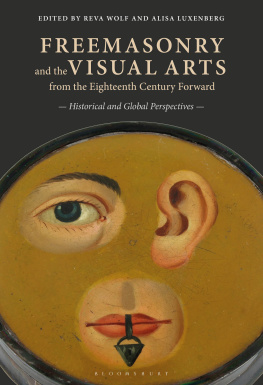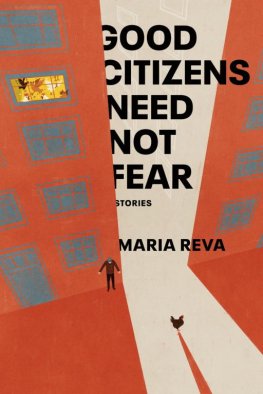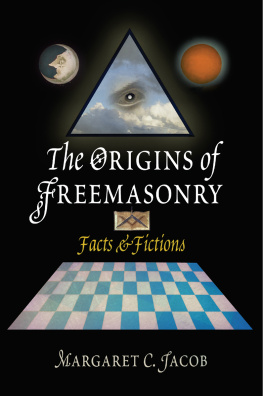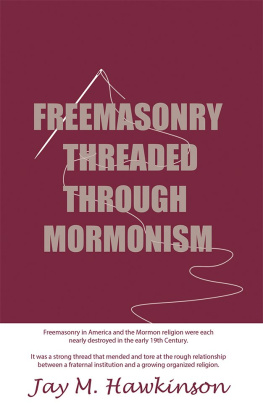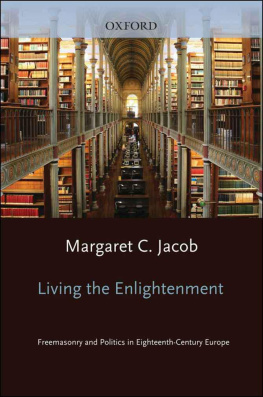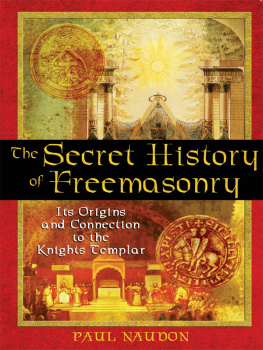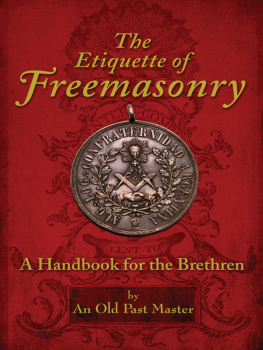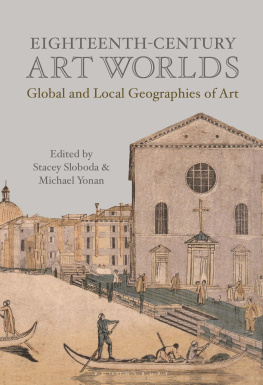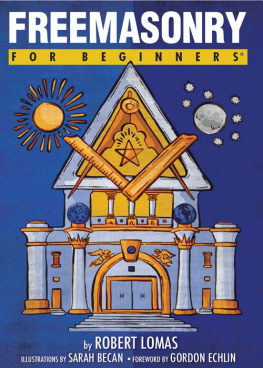Reva Wolf - Freemasonry and the Visual Arts From the Eighteenth Century Forward
Here you can read online Reva Wolf - Freemasonry and the Visual Arts From the Eighteenth Century Forward full text of the book (entire story) in english for free. Download pdf and epub, get meaning, cover and reviews about this ebook. year: 2019, publisher: Bloomsbury USA, genre: Romance novel. Description of the work, (preface) as well as reviews are available. Best literature library LitArk.com created for fans of good reading and offers a wide selection of genres:
Romance novel
Science fiction
Adventure
Detective
Science
History
Home and family
Prose
Art
Politics
Computer
Non-fiction
Religion
Business
Children
Humor
Choose a favorite category and find really read worthwhile books. Enjoy immersion in the world of imagination, feel the emotions of the characters or learn something new for yourself, make an fascinating discovery.
- Book:Freemasonry and the Visual Arts From the Eighteenth Century Forward
- Author:
- Publisher:Bloomsbury USA
- Genre:
- Year:2019
- Rating:5 / 5
- Favourites:Add to favourites
- Your mark:
- 100
- 1
- 2
- 3
- 4
- 5
Freemasonry and the Visual Arts From the Eighteenth Century Forward: summary, description and annotation
We offer to read an annotation, description, summary or preface (depends on what the author of the book "Freemasonry and the Visual Arts From the Eighteenth Century Forward" wrote himself). If you haven't found the necessary information about the book — write in the comments, we will try to find it.
Reva Wolf: author's other books
Who wrote Freemasonry and the Visual Arts From the Eighteenth Century Forward? Find out the surname, the name of the author of the book and a list of all author's works by series.
Freemasonry and the Visual Arts From the Eighteenth Century Forward — read online for free the complete book (whole text) full work
Below is the text of the book, divided by pages. System saving the place of the last page read, allows you to conveniently read the book "Freemasonry and the Visual Arts From the Eighteenth Century Forward" online for free, without having to search again every time where you left off. Put a bookmark, and you can go to the page where you finished reading at any time.
Font size:
Interval:
Bookmark:


| Thomas Stirling Lee (attrib.), Past Masters Jewel, Arts Lodge No. 2751, obverse and reverse, 1906, silver-colored metal. Library and Museum of Freemasonry, London. |
Working on this book was an exciting and enriching adventure into new territory, made all the more appealing by the captivating scholarship of the contributors, but also by the kindness and generosity of the many other individuals who shared their knowledge of various aspects of Freemasonry, or additional relevant areas of expertise, with us. We are deeply grateful to them all.
The seeds that grew into this book were planted in a session of the College Art Association 2016 annual conference in Washington, DC, organized by Reva, on Freemasonry and the Visual Arts. All the papers in that session ended up in our book, and we received beneficial insight and feedback from the sessions discussant, Aimee Newell, then Director of Collections at the Scottish Rite Masonic Museum and Library, Lexington, MA, and currently Executive Director, Luzerne County Historical Society, Wilkes Barre, PA. Other papers in this book were first presented at the Second World Conference on Fraternalism, Freemasonry, and History (WCFFH), held in 2017 at the Bibliothque Nationale de France in Paris. A special thanks goes to Paul J. Rich, President, Policy Studies Organization (PSO), Washington, DC, who allowed us to devote three panels to our topic, in a kind of conference within the WCFFH conference, entitled Freemasonry and the Visual Arts: A Symposium, which we co-chaired, and which gave several of the contributors an important venue for testing ideas and sharing material. Daniel Gutierrez-Sandoval, Director of Latin American Affairs at the PSO, assisted us with the conference logistics. We also extend our thanks to Guillermo De Los Reyes, Associate Professor of Latin American Culture and Literature, University of Houston, and Pierre Mollier, Director, Library, Archives and Museum for the Grand Orient de France, Paris, co-organizers of the 2017 WCFFH conference, for welcoming us and our speakers at this edifying forum.
We both were aided in our research by support from our home institutions. Reva received significant assistance from the State University of New York at New Paltz through a sabbatical leave in 20162017, Professional Development Fund awards from the School of Fine and Performing Arts for conference participation related to this project, and a United University Professions Individual Development Award to help fund her research in London. She also would like to thank her colleagues in the Department of Art History for their support and encouragement. Alisa is especially grateful to the Office of Research and the Willson Center for Humanities and Arts at the University of Georgia for granting her a course release in Fall 2017 to provide much-needed time to begin co-editing the volume and to finish her own essay for it. The libraries of our respective institutions were undaunted by our numerous interlibrary loan requests and were able to locate even the most elusive of publications.
Of further benefit was Revas Summer 2017 Ailsa Mellon Bruce Visiting Senior Fellowship at the Center for Advanced Study in the Visual Arts (CASVA), National Gallery of Art, Washington, DC. Reva would like to thank Elizabeth Cropper, Dean of CASVA, and the entire staff of CASVA and of the National Gallery of Art Library, for a most valuable and pleasant opportunity to pursue sustained research.
Two additional resources of key importance for our research were the Library of the House of the Temple, Washington, DC, where Assistant Librarian Larissa Watkins answered numerous questions and gave us access to many important publications, and where Librarian Joan Kleinknecht welcomed our endeavor, and the Library and Museum of Freemasonry, London, where Librarian Martin Cherry, Archivist and Records Manager Susan Snell, and Collections Manager Emma Roberts provided access to manuscripts, publications, and objects of relevance to our project, as well as early important guidance on the history and symbols of Freemasonry.
To aid in the publication costs of this volume, we received generous subventions from the Willson Center for Humanities and Arts at the University of Georgia and the State University of New York at New Paltz Research and Creative Projects Award Program. Further assisting to make our publication a reality was the thoughtful translation of Cordula Bischoffs essay from German into English by Vanessa Plumly, Lecturer in German at SUNY New Paltz, and the help with details of translations from Portuguese into English within David Martn Lpezs essay by Carmen Tesser, Professor Emerita at the University of Georgia. We thank Lindsey Reynolds, Visual Resources Curator, University of Georgia, and Susan DeMaio Smutny, Visual Resources Librarian, SUNY New Paltz, for their expert assistance with our digital technology questions. We also are grateful to each institution and individual who helped us and our authors with the acquisition of and permission to reproduce the images in this volume.
We are equally eager to thank the experts in various fields who provided useful suggestions, answered our questions, and offered feedback: Edward Sullivan, Deputy Director, Institute of Fine Arts, New York University, and Helen Gould Sheppard Professor in the History of Art, Institute of Fine Arts and College of Arts and Sciences, New York University; Michael Yonan, Associate Professor of Art History, University of Missouri-Columbia; Jeff Croteau, Director of Library and Archives, Scottish Rite Masonic Museum and Library, Lexington, MA; Jean-Mathieu Robine, independent scholar, Paris; Susan Sommers, Professor of History, Saint Vincent College; and Juan Antonio Yeves Andrs, Librarian, Museo Lzaro Galdiano, Madrid. And we are grateful, for their varied types of support, each meaningful and deeply appreciated, to Jonathan Brown, Mary Christiansen, Sean Dykhouse, Susan Galassi, Jean-Claude Lebensztejn, and Mercedes Rooney. Reva is particularly indebted to Eugene Heath for his constant and steady advice and support, and also would like to thank the extended Wolf and Heath clans for their encouragement.
Two anonymous readers of our book proposal offered questions and insights at the outset of our project that helped to guide us. We may not have succeeded in answering all their questions, but we believe that we benefited immensely from receiving them.
Margaret Michniewicz at Bloomsbury Academic has been a supportive and attentive editor, and her editorial assistant, Erin Duffy, answered our many questions promptly and with patience and clarity. At the early stages of this project, Katherine DeChant, also at Bloomsbury, helped us with myriad details of the project.
We conclude by offering our gratitude to our wonderful contributors, with whom it has been an immense pleasure to work, not only as they prepared their manuscripts for this volume, but also as they exchanged ideas at the conferences in Washington, DC, and Paris. Thank you for a wonderful, collegial collaborative enterprise.
Reva Wolf and Alisa Luxenberg
Given Freemasonrys focus on
After the publication of Andersons Constitutions, Freemasonry spread rapidly, and visual art was called into service to provide evidence of its remarkable dissemination.
Next pageFont size:
Interval:
Bookmark:
Similar books «Freemasonry and the Visual Arts From the Eighteenth Century Forward»
Look at similar books to Freemasonry and the Visual Arts From the Eighteenth Century Forward. We have selected literature similar in name and meaning in the hope of providing readers with more options to find new, interesting, not yet read works.
Discussion, reviews of the book Freemasonry and the Visual Arts From the Eighteenth Century Forward and just readers' own opinions. Leave your comments, write what you think about the work, its meaning or the main characters. Specify what exactly you liked and what you didn't like, and why you think so.

